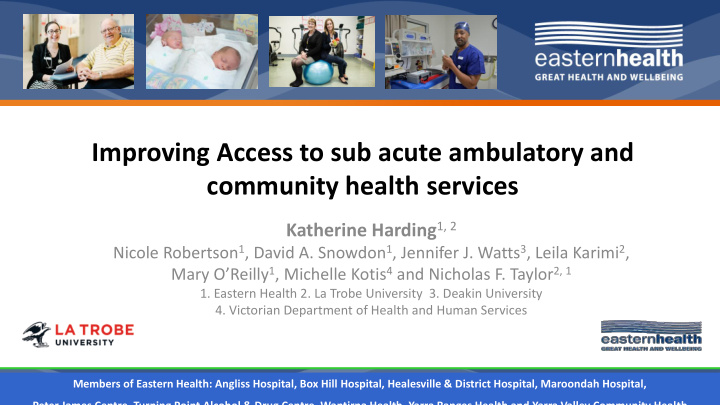



Improving Access to sub acute ambulatory and community health services Katherine Harding 1, 2 Nicole Robertson 1 , David A. Snowdon 1 , Jennifer J. Watts 3 , Leila Karimi 2 , Mary O’Reilly 1 , Michelle Kotis 4 and Nicholas F. Taylor 2, 1 1. Eastern Health 2. La Trobe University 3. Deakin University 4. Victorian Department of Health and Human Services Angliss Box Hill Healesville Hospital and Maroondah Peter James Wantirna Yarra Ranges Turning Spectrum Members of Eastern Health: Angliss Hospital, Box Hill Hospital, Healesville & District Hospital, Maroondah Hospital, Hospital Hospital Yarra Valley Health Hospital Centre Health Health Point Peter James Centre, Turning Point Alcohol & Drug Centre, Wantirna Health, Yarra Ranges Health and Yarra Valley Community Health
Waiting for care
Sub-acute Ambulatory and Community Health Services Group of services provided in the community to support return to the community following a hospital stay, or maintain health in community settings. Community health centres Allied Health Specialist Services clinics Community Community based mental health rehabilitation services
Eastern Health • Covers a geographical area of more than 2800km 2 across the Eastern suburbs of Melbourne • 6 sites providing inpatient care • More than 73,000 ambulatory appointments annually
Aim of this Study To identify features of ambulatory services that are associated with long waiting times
Qualitative Design • Semi structured interviews with senior employees (n= 26) of community health, allied health outpatient and sub acute ambulatory services within Eastern Health. • Interviews transcribed, data coded and analysed thematically
Key themes When someone has to take sick • Staffing issues/ leave or carers leave there’s no backfill, so those appointments then Lack of resources get pushed further down – Lack of leave cover – Recruitment delays There’s so many people that need to – Part time work force be seen, there’s no other service • Too many referrals – Lack of alternative service providers
Inefficiencies in access processes …we don’t get any information that we really need then we get all this extra bit that we’re not that interested in I think intake take too much information…. I love the fact that they are thorough, but they are going into too much detail that I then need to ask the client anyway so it’s just repetitive
Inefficiencies in scheduling • DNA rates Probably the other thing that is a big issue for us is failure to attend….They call up or last • Difficulty getting minute changes where we can’t fill the diary. onto patients – You are always chasing people for multiple phone calls appointments, returning phone calls, emails • Inefficient use of and things. available clinic time There is a lot of calling families back when they have called to say I haven’t been seen or I haven’t heard anything.
Acceptance of waiting • Benchmarking/ we are looking at 6 week for priority 2’s…so I would say we are providing comparison an excellent service in comparison [to similar services]. to other services • KPIs Our category 3 referrals we are seeing within our 6 week KPI.
So what’s the answer? Can we reduce waiting times for ambulatory care? • Understand supply and demand • Simply increasing resources doesn’t always reduce waiting time • Perception not always correct • Demand>supply Keep admin and booking processes simple Average time from referral to = increasing waits • over time Maximise use of existing supply • Failure to attend, ‘right patients, right service’ service delivery • Maintain Flexibility • Budget for leave cover, forward planning Demand=supply, but constant backlog = constant delay
STAT Model: Specific Timely Appointments for Triage Analysis of supply and demand One off intervention (+/- additional resources) to reduce existing wait list Specific, protected appointments created in clinician diaries for new assessments required to meet demand Patients immediately booked into first available assessment slot on referral Clinicians assess and determine priority with the context of existing caseload
Why do we think STAT might work? Supply/demand relationship is carefully analysed and balanced Referral Reduces admin processes Waiting list • Patients booked in immediately on management Assessment Multiple referral/1 st contact – minimal phone calls ‘phone tag’ Duplication Complex triage • Minimal triaging processes • No need to maintain a waiting list
Why do we think STAT might work? Maintains flexibility • Clinicians make priority decisions in the context of demand • Number of new patient slots can be adjusted to plan for seasonal variations in demand Patient-centred • Access decisions based on clinical needs of patients, not benchmarking or arbitrary targets and KPIs.
Does it work? STAT has been shown to reduce waiting time by 40% in pilot trials in community rehabilitation and outpatient physiotherapy. A large trial of STAT funded by the NHMRC and DHHS is currently underway at Eastern Health involving 8 diverse ambulatory and community health services and over 3000 patients.
Conclusion • Waiting times for ambulatory and community services are an issue • Some service factors are associated with waiting time • Clinicians and managers consistently report too much demand and insufficient staff as the primary reason for wait times. ….BUT ALSO • Organisational factors have been identified that contribute to waiting time, and represent opportunities to better use available resources • The STAT model attempts to address many of these factors: we look forward to reporting whether it can be successful on a large scale.
For further information…. BMC Health Services Research Are wait lists inevitable in subacute ambulatory and community health services? A qualitative analysis Katherine E. Harding, Jennifer J. Watts, Leila Karimi, Katherine E. Harding, Nicole Robertson, Mary O’Reilly, Bridie Kent, Michelle Kotis, Sandra G. David A. Snowdon, Jennifer J. Watts, Leila Karimi, Leggat, Jackie Kearney and Nicholas F. Taylor Mary O’Reilly, Michelle Kotis and Nicholas F. Taylor http://bmchealthservres.biomedcentral.com/articles/ http://dx.doi.org/10.1071/AH16145 10.1186/s12913-016-1611-3 Accepted: 9 December 2016 Accepted: 30 th July 2016 Published online: 30 January 2017 Published online: 9 th August 2016 katherine.harding@easternhealth.org.au Allied Health Clinical Research Office Eastern Health, 5 Arnold St, Box Hill. Ph: 9091 8880 @EH_Research
Recommend
More recommend